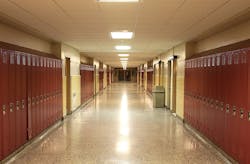Although schools have been profoundly affected by tragedies—from shooting attacks to weather disasters—administrators face much uncertainty and confusion about the best way to respond. Does a school have to become a fortress? Can a school still be full of daylight and inspiring spaces to support learning and welcome families? What are the best ways to meet community needs?
Architects are demonstrating that schools can be filled with daylight and inviting and still have robust safety measures, put seamlessly into place without becoming a fortress. The best designs are practical, budget conscious and low-key.
These elements emerge as key steps that help keep schools safe:
- Protect the perimeter of the school campus
- Secure all entries and control visitor access to buildings
- Increase visibility of hallways and classrooms to monitor behavior
- Communicate with law enforcement and train staff and students to stay safe
Protect the Perimeter
Slowing down intruders until law enforcement arrives is critical. Create layers of protection to deter intruders, starting with the site perimeter.
Fencing
- Provide fencing around the entire site. Install gates at drive lanes to regulate vehicles’ access to the site.
- Provide fencing to separate parking lots and drive lanes from the rest of the school grounds. Install fencing around play areas to prevent intruders from gaining access to students outside.
Building Perimeter
Creating a separation between the entry to the school and the drive lane will slow down an intruder. Providing the proper visual supervision of the front of the school will give staff more time to prepare and alert the authorities to suspicious behavior. Strategies include:
- Create a plaza area between the building entry and the parking lots and drive lanes so that for visitors can be more easily seen approaching the building.
- Install bollards to keep vehicles off sidewalks.
- Provide separate drive lanes for buses and parents dropping off students.
- Create a bioswale, a recessed vegetated area, to deter visitors from gaining access to perimeter windows.
- Install cameras along the perimeter of the building, aimed at both the building entry and out toward drive lanes and parking lots.
- Prune or remove shrubbery to improve visual supervision of the building exterior and to eliminate areas where intruders may hide.
- Keep all exterior doors locked throughout the day. On doors used only for emergency egress, consider removing the hardware on the exterior of the door.
Securing Entries and Controlling Access
Entry Vestibule
The main building entry is the most likely place for intruders to get inside a school. Strategies for securing the entry include:
- Install intruder-resistant glass or film to slow down the time it takes to break through the glass.
- Provide a secure vestibule that requires visitors to be buzzed through two sets of doors before gaining entry into the rest of the facility.
- Install a bullet-resistant transaction window between the vestibule and administrative office and require visitors to sign in before gaining access into the rest of the school.
Building Layout
- Place all administration offices and those spaces not regularly used by students at the front of the building. Place all classrooms toward the back of the building.
- In hallways, install double doors capable of being closed and locked automatically in a lockdown.
- For deliveries, provide designated areas secured from the rest of the building.
Increasing Visibility and Communication with Law Enforcement
Hallways and Classrooms
- Add cameras to hallways and areas within the building that do not have adequate visual supervision.
- Install intruder-resistant glass or film to entry doors and sidelites.
- Provide a means for locking classroom doors from the classroom side of the door.
- Keep classroom doors locked during school hours or provide a way for doors to be automatically locked in a lockdown.
- Place room numbers on the exterior windows, visible to first responders approaching the building; above the classroom side of the door, visible to teachers and students contacting first responders; and in the hallways perpendicular to the wall so that first responders can view room numbers from a distance.
- Provide a clear, unobstructed, “out-of-sight” zone in the classroom where students can hide out of the line of sight from the door.
- Provide a communication system for teachers to alert administration and police of safety concerns.
Looking Ahead
Several states have been establishing budgets for purchasing safety equipment, training and communications, and monitoring equipment. In addition, some school bond referendum are dedicating a portion of their funding requests to security upgrades.
Creating a comprehensive school safety plan is a team effort. It involves administration, faculty, parents, students, law enforcement and design professionals. Every school has specific challenges and priorities, which should be addressed on a case-by-case basis.
About the Author
Art Bond
Principal and Co-Creator
Bond, AIA, is principal and co-creator of Bond Architects, Inc., based in St. Louis, an architecture, interior design and planning firm specializing in K-12 environments and security. He can be reached at 314-863-4994 or [email protected].
